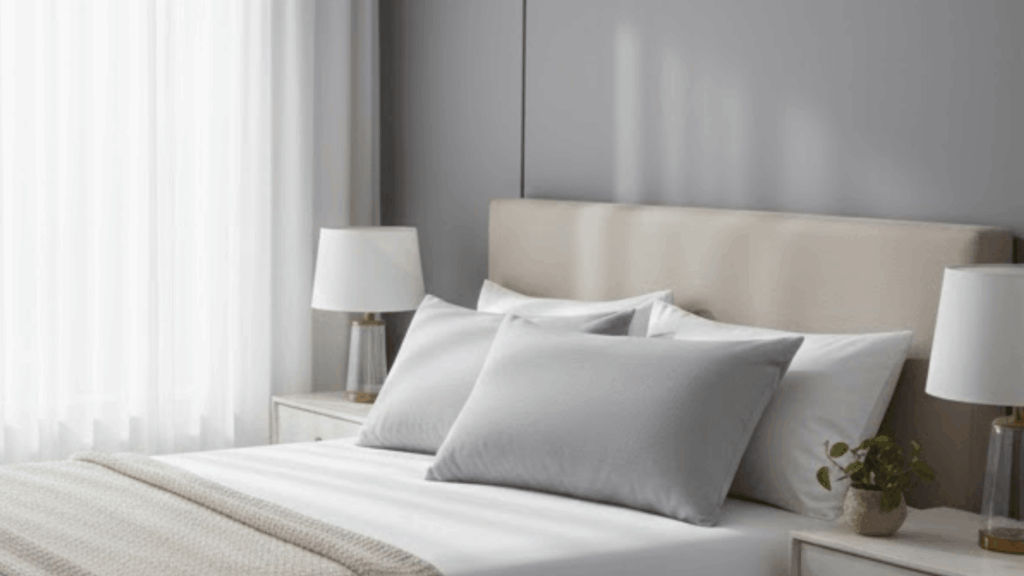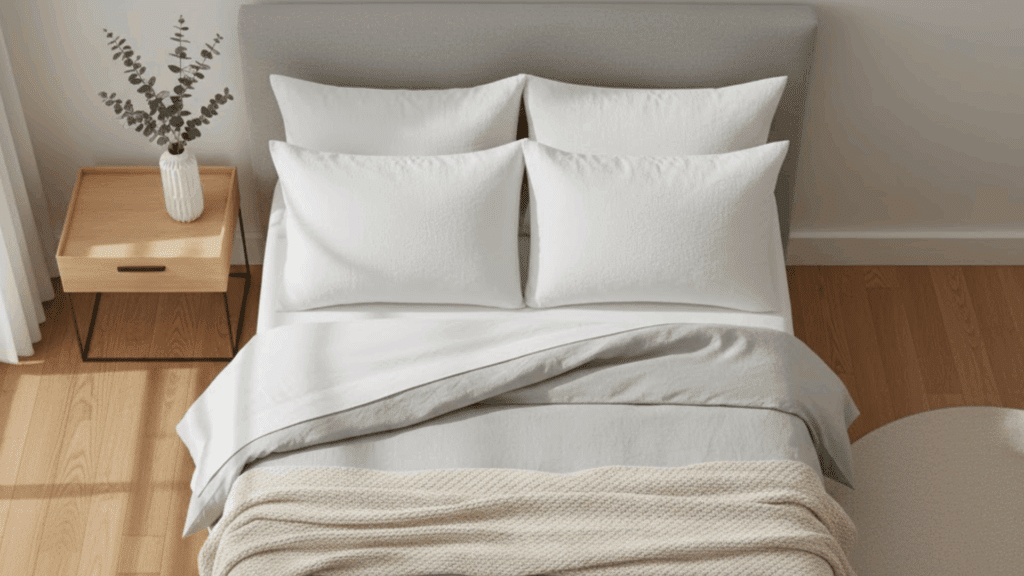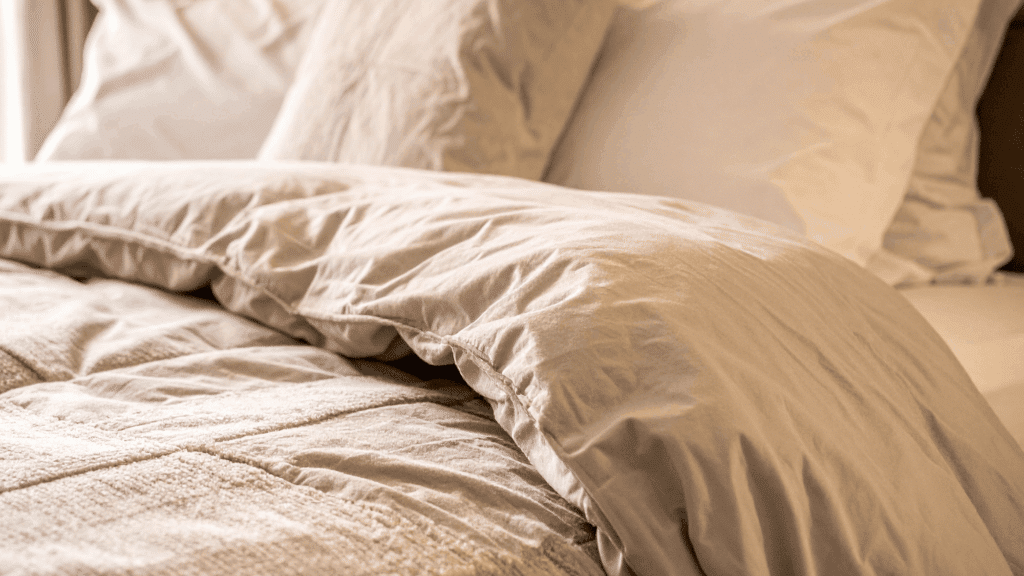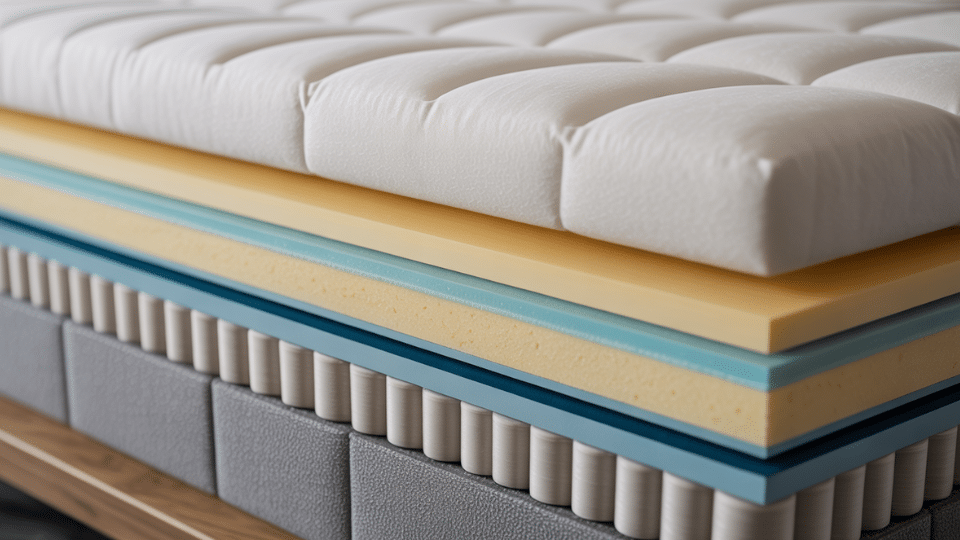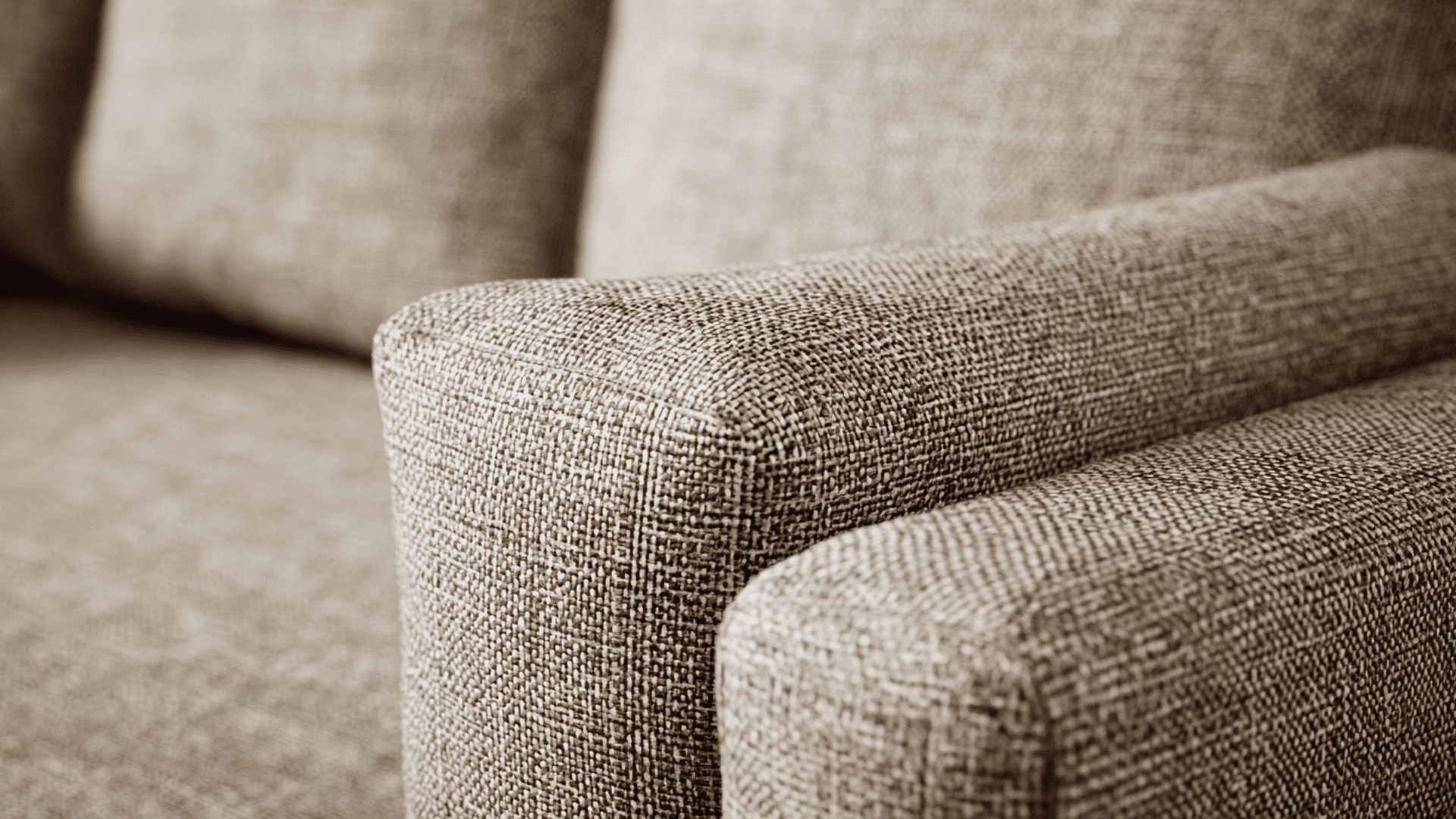I’ll be honest: I used to think all pillows were basically the same size. Then I upgraded to a Queen pillow and realized I’d been missing out on serious comfort.
Here’s the thing: Standard and Queen pillows might look nearly identical at first glance, but that extra length makes a real difference for how you sleep and how your bed looks.
If you’re a restless sleeper who needs more surface area or you’re trying to make your bedding look perfectly proportioned, understanding these size differences matters.
I’m breaking down everything you need to know, from exact dimensions to which pillow works best for your sleeping style, bed size, and appeal goals.
Standard Pillow Size Explained
Standard pillows measure 20 x 26 inches (51 x 66 cm) and typically come in low to medium loft. They’re the most common size you’ll find and work beautifully on Twin or Full beds without overwhelming the space.
I recommend them for solo sleepers who don’t move around much at night; you get enough surface area for comfortable head and neck support without excess bulk.
The pros? They’re affordable, widely available, and fit most standard pillowcases perfectly.
The cons? If you’re a restless sleeper, you might find yourself rolling off the edge. They can also look a bit small on Queen or King beds, leaving gaps that throw off the visual balance of your bedroom.
Queen Pillow Size Explained
Queen pillows measure 20 x 30 inches (51 x 76 cm); that extra four inches of length makes a genuine difference. They come in various loft options from low to high, with fill choices ranging from memory foam to down alternative to traditional feathers.
These are my go-to recommendations for Queen or King beds, where they create a more proportional, luxurious look.
They’re perfect for couples sharing a bed and active sleepers who shift positions throughout the night; that added width gives you room to move without your head slipping off the edge.
The pros? Better edge-to-edge support, improved bed aesthetics, and more versatility for different sleeping positions.
The cons? They cost slightly more than Standard pillows, and you’ll need Queen-sized pillowcases, which can be harder to find in certain styles.
Standard vs. Queen Pillow: Side-by-Side Comparison

Let me break down the key differences so you can see exactly what sets these two sizes apart. Understanding how they compare in real-world use helps you make a smarter choice for your sleep quality and bedroom setup.
1. Key Specifications at a Glance
Here’s everything you need to know in one place. This table highlights the fundamental differences that affect both your comfort and how your bed looks:
| Feature | Standard Pillow | Queen Pillow |
|---|---|---|
| Dimensions | 20 x 26 inches (51 x 66 cm) | 20 x 30 inches (51 x 76 cm) |
| Ideal Bed Size | Twin, Full | Queen, King |
| Best Sleep Position | Back, stomach sleepers | All positions, especially the side |
| Price Range | More affordable | Slightly higher cost |
| Aesthetic Impact | Can look small on larger beds | Proportional, hotel-style look |
2. Surface Area and Movement Support
That four-inch length difference gives you significantly more room to shift around. Queen pillows provide about 15% more surface area, which means you’re less likely to roll off the edge during the night.
If you’re someone who tosses and turns or changes positions frequently, this extra real estate keeps your head and neck supported no matter where you land. Standard pillows work fine for stationary sleepers, but active sleepers quickly notice the limitations.
3. Edge-to-Edge Comfort Comparison
Edge support is where Queen pillows really shine:
- The extended width means your head stays centered even when you move toward the sides.
- This especially matters for side sleepers—you can shift from left to right without losing that crucial neck alignment.
- Standard pillows leave less margin for error, so you might find yourself waking up to readjust or dealing with neck strain from sleeping too close to the edge.
4. Pillow Hugging and Body Positioning
If you’re a pillow hugger or like to tuck your pillow under your arm while sleeping, Queen pillows accommodate this better. The extra length supports your head while leaving room for your arms or upper body.
Standard pillows can feel cramped when you try to cuddle them, forcing you to choose between head support and comfort. This also applies to combination sleepers who switch between back and side positions throughout the night.
How Does Pillow Size Affect Sleep Quality?
Pillow size isn’t just about comfort; it directly impacts how well your body aligns during sleep and how rested you feel in the morning.
Here’s what happens when you match the right size to your needs:
- Neck And Spinal Alignment: A pillow that’s too narrow for your sleeping style can cause your head to tilt awkwardly, throwing your spine out of alignment and leading to morning stiffness or pain.
- Shoulder Width Matters: Side sleepers with broader shoulders need the extra length of Queen pillows to keep their head level with their spine without their shoulder pushing them off the pillow’s edge.
- Breathing and Airway Openness: A Proper pillow size keeps your head elevated at the right angle, preventing your chin from tucking into your chest or your head from tilting back, both of which can restrict airflow.
- Size Works With Loft And Firmness: A larger pillow gives you more adjustable surface area to find your ideal sleeping position, especially when paired with the right loft height and firmness level for your body type.
- Movement Freedom Reduces Disruption: Queen pillows let you shift positions without losing support, meaning fewer mid-night adjustments that interrupt your deep sleep cycles.
The right pillow size supports proper alignment, keeps your airways open, and lets you move naturally throughout the night for genuinely better sleep quality.
Bed Size Compatibility Guide
Matching your pillow size to your mattress creates a balanced look and ensures you’re using your bed’s full width effectively.
Here’s how each pillow size pairs with different mattress dimensions:
| Mattress Size | Mattress Width | Best Pillow Choice | Why It Works |
|---|---|---|---|
| Twin / Twin XL | 38 inches | Standard only | Queen pillows would hang over the edges and look oversized |
| Full | 54 inches | Standard works best | Two Standard pillows fit perfectly across the width |
| Queen | 60 inches | Both fit; Queen gives better coverage | Two Queen pillows create a fuller, more proportional look |
| King | 76 inches | Queen works but doesn’t fully fill | Consider King-size pillows (20 x 36 inches) for complete coverage |
A helpful visual tip: Lay your pillows across your mattress to see the spacing. If there are noticeable gaps between pillows or they look lost on the bed, size up for a better proportion and comfort.
How Pillow Size Changes Your Bedroom’s Look And Feel
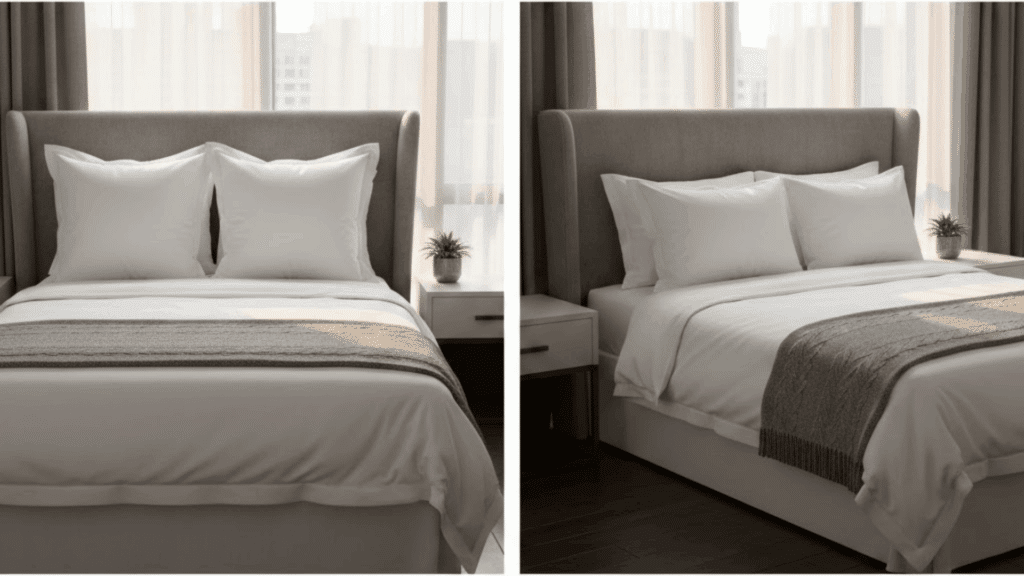
Beyond comfort, pillow size plays a major role in how polished and intentional your bedroom looks. Here’s how to style each size for maximum visual impact:
- Twin and Full Beds: Standard pillows are your best bet for a clean, proportional look that doesn’t overwhelm smaller mattresses or make the bed appear crowded.
- Queen and King Beds: Queen pillows create that fuller, hotel-inspired aesthetic with minimal gaps, while Standard pillows can look undersized and leave awkward spacing.
- Minimalist Setups: Stick to two matching pillows in the appropriate size for your bed, skip decorative shams, and let the clean lines speak for themselves.
- Layered Luxury Hotel Look: Start with two or three Queen sleeping pillows, add Euro shams (26 x 26 inches) behind them, then finish with smaller accent pillows (18 x 18 inches) in front.
- Narrow Nightstands And Small Rooms: Standard pillows work better in tight spaces because they take up less visual real estate and keep the room feeling open rather than cluttered.
- Throw Pillow Pairings: Standard pillows pair well with 16 x 16-inch throw pillows, while Queen pillows balance better with 18 x 18 or 20 x 20-inch decorative accents.
Choose pillow sizes that complement your bed’s scale and your room’s proportions. The right combination makes your entire bedroom feel more cohesive and thoughtfully designed.
Pillowcase and Bedding Considerations
Standard pillows fit loosely in Queen cases, creating extra fabric bunching that some people find comfortable but others consider sloppy. Queen pillows don’t fit in Standard cases without stretching or bulging awkwardly.
For fabric choices, cotton percale offers crisp breathability, sateen provides silky smoothness, and bamboo delivers cooling moisture-wicking properties.
All work well with either size, though tighter weaves like percale show size mismatches more obviously.
Envelope-style pillowcases give you slightly more flexibility with size variations since the open back allows some adjustment.
Zippered cases need precise sizing, or you’ll struggle with closure or end up with excess fabric. Always match your pillowcase size to your pillow for the best fit and appearance.
Best Pillow Size For Each Sleeper Type

Your sleeping position determines how much pillow surface area you actually need throughout the night. Here’s how to match pillow size to your dominant sleep style for better comfort and support.
1. Side Sleepers
Queen pillows (20 x 30 inches) are ideal for side sleepers because the extra length accommodates your head when you shift from one side to the other. You need that extended surface to maintain proper spinal alignment as your shoulders press into the mattress.
The added width prevents your head from rolling off the edge, which is especially important since side sleeping requires a higher loft to fill the gap between your ear and shoulder.
2. Back Sleepers
Standard pillows (20 x 26 inches) work perfectly fine for back sleepers since you’re staying relatively centered throughout the night. You don’t need the extra width because you’re not moving laterally as much.
However, if you tend to drift toward the edges or occasionally shift to your side, Queen pillows provide that extra security. Focus more on finding the right loft; medium firmness works best to support your neck’s natural curve.
3. Combo Sleepers
Queen pillows are the clear winner for combination sleepers who switch positions multiple times per night. That extra surface area means you’re covered whether you roll onto your side, back, or stomach.
The additional length gives you room to move without constantly readjusting your pillow or waking up with your head hanging off the edge, which can seriously disrupt your sleep quality and leave you with morning neck pain.
4. Stomach Sleepers
Pillow size matters less for stomach sleepers since you need minimal loft to avoid neck strain. Standard pillows work fine because you’re typically keeping your head centered and not moving much side to side.
What really matters here is finding a soft, low-loft pillow that keeps your spine neutral. Many stomach sleepers actually prefer thinner pillows or even sleeping without one, so don’t stress about upgrading to Queen size for this position.
5. Hot Sleepers
Queen pillows give hot sleepers more room to shift away from warm spots that develop during the night. The larger surface area means you can move to a cooler section without losing support.
Look for breathable fabrics like bamboo or cooling gel-infused memory foam in Queen size. The extra space also improves air circulation around your head and neck, helping regulate temperature.
How Much Do Standard and Queen Pillows Cost?
Pillow size does affect cost, but the real price driver is what’s inside the pillow.
Here’s what you can expect to pay and where to find each size:
| Factor | Standard Pillows | Queen Pillows |
|---|---|---|
| Budget Range | $10 – $30 | $15 – $40 |
| Mid-Range | $30 – $80 | $40 – $100 |
| Premium Range | $80 – $200+ | $100 – $250+ |
- Material Impact: Memory foam and latex cost significantly more than polyester fill, regardless of size, while down and down alternative sit in the middle price range, and hybrid models command premium prices.
- Major US Brands: Both sizes are widely available at Target, Walmart, Amazon, Bed Bath & Beyond, and Wayfair, though Queen pillows have slightly less variety in budget options.
- Availability: Standard pillows dominate with universal availability and hundreds of options at every price point, while Queen pillows offer a good selection but fewer choices in decorative patterns and niche materials.
Final Thoughts
I’ve walked you through everything that separates Standard and Queen pillows, from exact dimensions to how they affect your sleep quality and bedroom appeal.
The choice really comes down to your bed size, sleeping habits, and whether you need that extra surface area for movement.
Queen pillows offer better edge support and a more proportional look on larger beds, while Standard pillows excel on Twin and Full mattresses.
Now that you understand the Standard vs. Queen pillow differences, which size works best for your setup? Drop a comment below and let me know what you’re sleeping on tonight.


